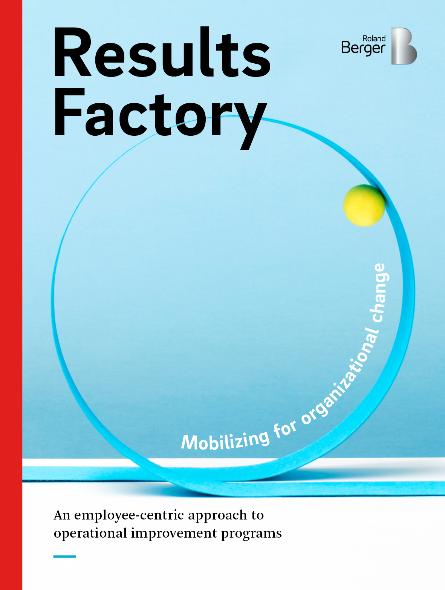Pressure on transportation operations to reduce emissions is rising. Our consultants help you define actionable pathways for reducing CO2 emissions, while securing a competitive edge


Results Factory – Mobilizing for organizational change
By Heiko Ammermann and Heiko Mosetter
An employee-centric approach to operational improvement programs
We live in difficult times. Companies around the globe are realizing that they need to make their operations more resilient in the face of uncertainties about the future of business in a post-pandemic world. But the traditional approach to improving operations – a three-step process of analysis, concept and implementation – is by its very nature too inflexible for today's realities. What companies need is an approach designed to unleash the creative power within the organization, provide tangible results and deliver greater flexibility. Say hello to the Results Factory.

"The Results Factory delivers results in the same way a factory delivers products: reliably, continuously and measurably."
A hands-on approach to improving operational efficiency
The traditional approach to improving operational efficiency, with its step-by-step methodology, provides stability and control. It favors command-and-control over local problem-solving: The management makes the decisions and imposes them top-down on the organization. The problem is that this limits the creativity of the workforce. Not only that, it often leads to limited buy-in on the part of the very people who need to implement the changes, which can ultimately cause the project to fail.
Our Results Factory approach is different. It improves operational efficiency in a truly hands-on manner, delivering results that are both tangible and measurable. Vitally, the direct involvement of the workforce in mixed teams or "squads" means that changes are generated bottom-up through the organization, jump-starting implementation and ensuring that any improvements are sustainable .
The Results Factory approach begins with what we call the Fast Forward phase, lasting one to two weeks. The leadership appoints a core team, which sets the overall goals of the reorganization with support from our consultants. The team develops a short, prioritized agenda that includes a scope, targets and an initial portfolio of actions. It then sets up a number of cross-functional squads, whose task is to develop actions for improving operational efficiency drawing on the creativity of the various squad members.
The Fast Forward phase is followed waves or streams of work focused on different topics, typically lasting four to eight weeks. The work within squads is organized into sprints. Once every two weeks, a "pit stop" is held – a plenary session where everyone comes together and the squads present updates on their work. At the pit stops, the squads also challenge each other and generate new ideas, while the leadership ensures overall project alignment. A central tracking system charts the implementation of each new action developed by the squads.
"Initiatives are designed around the client's line organization, which ensures both traction and results. Projects can be continuously adjusted to changing environments, and no big budget gamble is required."
What makes the Result Factory different?
The Results Factory stands out from traditional approaches in that it puts the organization firmly in the driving seat – in other words, the people who actually deal with the challenges on a day-to-day basis. It also focuses on results that directly impact the profit and loss account. Moreover, it is a "fail fast" approach: Rather than engaging in a lengthy concept phase, the squads implement actions immediately on a try-it-and-see basis, making improvements in later iterations. The Results Factors also enables adaptability , as it does not require big-bang investments. As a result, the company can continuously adapt, refine, roll out or abandon actions without causing major financial damage. Also unique to this approach is the fact that the squads develop and quickly implement actions "on the job", an approach that unleashes creativity within the workforce and overcomes organizational silos.
The four principles
The Results Factory in underpinned by four principles:
Principle #1: Focus on implementation
The Results Factory places the emphasis on implementing changes within the organization. The role of the consultant team is purely to help the company get things done.
Principle #2: Timebox the work
A certain amount of time is allocated for each activity, and the activity is then completed within that timeframe – a process known as "timeboxing".
Principle #3: Know your purpose
Without a clear vision and purpose, any endeavor is doomed to failure. Ultimately, the purpose of the Results Factory is to improve the organization's performance.
Principle #4: Be a role model
The leadership of the company must model a culture of fast decision-making, avoiding lengthy analyses, being courageous, taking risks and focusing on implementation.
Register now to download the white paper to make your organization fit and resilient for the future and get regular insights into Infrastructure topics.







_person_144.png)